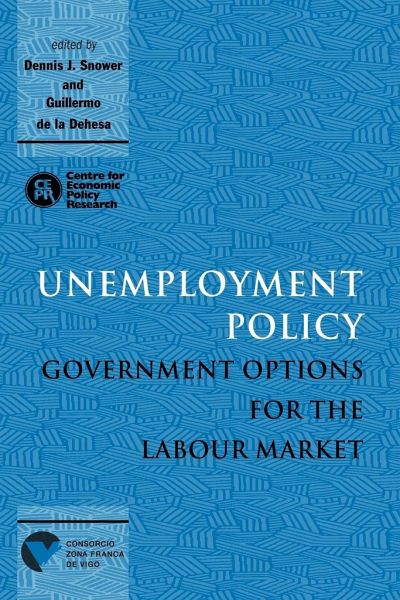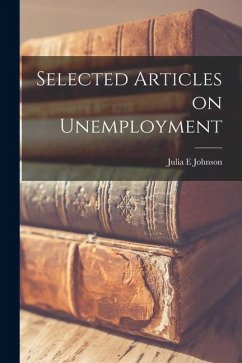
Unemployment Policy
Government Options for the Labour Market
Herausgeber: Snower, Dennis J.; Dehesa, Guillermo De La; De La Dehesa, Guillermo
Versandkostenfrei!
Versandfertig in 1-2 Wochen
61,99 €
inkl. MwSt.

PAYBACK Punkte
31 °P sammeln!
There is substantial disagreement among policy-makers about how governments should respond to the problem of high unemployment. Thus far there has been little, if any, systematic attempt to evaluate the strengths and weaknesses of the main unemployment policies available to governments in market economies. Individual policy recommendations are usually made in isolation from one another. This book attempts to provide a balanced assessment of the various policy options, including the following: demand management versus supply-side policy, subsidizing employment and training, restructuring labour...
There is substantial disagreement among policy-makers about how governments should respond to the problem of high unemployment. Thus far there has been little, if any, systematic attempt to evaluate the strengths and weaknesses of the main unemployment policies available to governments in market economies. Individual policy recommendations are usually made in isolation from one another. This book attempts to provide a balanced assessment of the various policy options, including the following: demand management versus supply-side policy, subsidizing employment and training, restructuring labour market regulations, and reforming the welfare state. The book also examines the political economy of unemployment policy and the effect of this policy on productivity growth.
Table of contents:
1. Introduction Guillermo de la Dehesa and Dennis J. Snower; Part I. General Policy Issues: 2. Evaluating unemployment policies: what do the underlying theories tell us? Dennis J. Snower; 3. High unemployment from a political economy perspective Gilles Saint-Paul; Part II. Demand Management and Supply-Side Policy: 4. The role of demand-management policies in reducing unemployment Charles R. Bean; 5. Edmund Phelps' theory of structural slumps and its policy implications Edmond Malinvaud; Part III. Subsidising Employment and Training: 6. The simple economics of benefit transfers Dennis J. Snower; 7. Wage subsidy programmes: alternative designs Edmund S. Phelps; 8. Technological development, competition from low-wage economies and low-skilled unemployment Jacques H. Drèze and Henri Sneessens; 9. Macroeconomic and policy implications of shifts in the relative demand for skills Olivier J. Blanchard; 10. Would cutting payroll taxes on the unskilled have a significant impact on unemployment? Stephen J. Nickell and Brian Bell; 11. Preventing long-term unemployment: an economic analysis Richard Layard; Part IV. Labour Market Regulations: 12. An analysis of firing costs and their implications for unemployment policy Alison L. Booth; 13. Labour market regulation and unemployment Paul Gregg and Alan Manning; Part V. Policy, Job Reallocation and the Unemployment-Productivity Relation: 14. Is there a trade-off between unemployment and productivity growth? Robert J. Gordon; 15. Gross job reallocation and labour market policy Pietro Garibaldi, Jozef Konings and Christopher Pissarides; Part VI. Comparing Unemployment Policies: 16. Unemployment in the OECD and its remedies Patrick Minford; 17. The unemployment and welfare effects of labour market policy: a comparison of the US and the UK Stephen P. Millard and Dale T. Mortensen.
This book examines the main policies available to the government in dealing with the problem of high unemployment. It attempts to evaluate the strengths and weaknesses of the main unemployment policies in market economies, providing a balanced assessment of the various options.
This book looks at a range of policies available to tackle unemployment.
Table of contents:
1. Introduction Guillermo de la Dehesa and Dennis J. Snower; Part I. General Policy Issues: 2. Evaluating unemployment policies: what do the underlying theories tell us? Dennis J. Snower; 3. High unemployment from a political economy perspective Gilles Saint-Paul; Part II. Demand Management and Supply-Side Policy: 4. The role of demand-management policies in reducing unemployment Charles R. Bean; 5. Edmund Phelps' theory of structural slumps and its policy implications Edmond Malinvaud; Part III. Subsidising Employment and Training: 6. The simple economics of benefit transfers Dennis J. Snower; 7. Wage subsidy programmes: alternative designs Edmund S. Phelps; 8. Technological development, competition from low-wage economies and low-skilled unemployment Jacques H. Drèze and Henri Sneessens; 9. Macroeconomic and policy implications of shifts in the relative demand for skills Olivier J. Blanchard; 10. Would cutting payroll taxes on the unskilled have a significant impact on unemployment? Stephen J. Nickell and Brian Bell; 11. Preventing long-term unemployment: an economic analysis Richard Layard; Part IV. Labour Market Regulations: 12. An analysis of firing costs and their implications for unemployment policy Alison L. Booth; 13. Labour market regulation and unemployment Paul Gregg and Alan Manning; Part V. Policy, Job Reallocation and the Unemployment-Productivity Relation: 14. Is there a trade-off between unemployment and productivity growth? Robert J. Gordon; 15. Gross job reallocation and labour market policy Pietro Garibaldi, Jozef Konings and Christopher Pissarides; Part VI. Comparing Unemployment Policies: 16. Unemployment in the OECD and its remedies Patrick Minford; 17. The unemployment and welfare effects of labour market policy: a comparison of the US and the UK Stephen P. Millard and Dale T. Mortensen.
This book examines the main policies available to the government in dealing with the problem of high unemployment. It attempts to evaluate the strengths and weaknesses of the main unemployment policies in market economies, providing a balanced assessment of the various options.
This book looks at a range of policies available to tackle unemployment.














